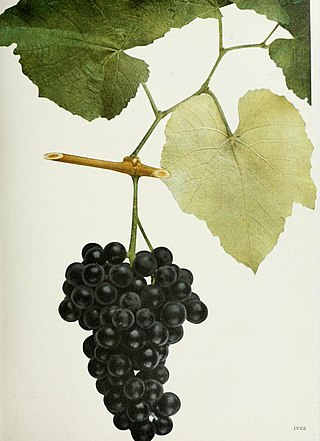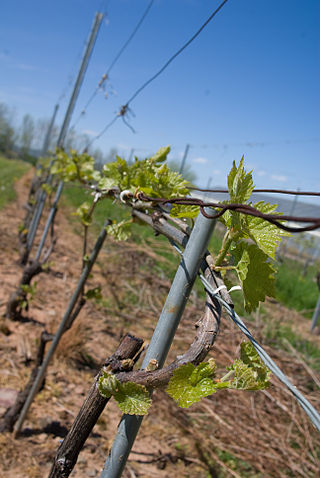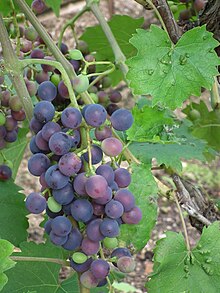
Aurore is a white complex hybrid grape variety produced by French viticulturist Albert Seibel and used for wine production mostly in the United States and Canada. Over a long lifetime, Seibel produced many complex hybrid crosses of Vitis vinifera to American grapes. The Aurore grape is a cross of Seibel 788 and Seibel 29.

Seyval blanc is a hybrid wine grape variety used to make white wines. Its vines ripen early, are productive and are suited to fairly cool climates. Seyval blanc is grown mainly in England, the United States East Coast, in the Pacific Northwest (Oregon), as well as to a lesser extent in Canada. Seyval blanc was created either by Bertille Seyve, or his son-in-law Villard, as a cross of Seibel 5656 and Rayon d'Or, and was used to create the hybrid grape St. Pepin. Seyve and Villard used the same Rayon d'Or x Seibel 5656 crossing to produce the red wine grape Seyval noir.
Seibel grapes are a group of wine grape varieties which originated with the work of French viticulturist Albert Seibel crossing European wine grape with American grape species to increase disease resistance. They were planted widely in France during the 1950s but have seen decline in recent years because French wine law prohibits hybrid grapes in appellation wine. The grapes are still commonly used as blending grapes in table wine and mass commercial wines. New Zealand, England, and Canada also have plantings of Seibel grapes.

Baco blanc or Baco 22A is a French-American hybrid grape variety. It is a cross of Folle blanche and the Noah grape, created in 1898 by the grape breeder François Baco. Folle blanche is its Vitis vinifera parent. Noah, its other parent, is itself a cross of Vitis labrusca and Vitis riparia.

Vidal blanc is a white hybrid grape variety produced from the Vitis vinifera variety Ugni blanc and another hybrid variety, Rayon d'Or. It is a very winter-hardy variety that manages to produce high sugar levels in cold climates with moderate to high acidity.

Hybrid grapes are grape varieties that are the product of a crossing of two or more Vitis species. This is in contrast to crossings between grape varieties of the same species, typically Vitis vinifera, the European grapevine. Hybrid grapes are also referred to as inter-species crossings or "Modern Varieties." Due to their often excellent tolerance to powdery mildew, other fungal diseases, nematodes, and phylloxera, hybrid varieties have, to some extent, become a renewed focus for European breeding programs. The recently developed varieties are examples of newer hybrid grape varieties for European viticulturalists. Several North American breeding programs, such as those at Cornell and the University of Minnesota, focus exclusively on hybrid grapes, with active and successful programs, having created hundreds if not thousands of new varieties.
Plantet is a red wine grape variety that was one of the hybrid grape created by French physician and grape breeder Albert Seibel. While the exact parentage of the grape is unknown, the most popular theories has it as a cross of two Seibel grapes, Seibel 867 x Seibel 2524 with another theory speculating that Plantet's parentage was Seibel 4461 crossed with Berlandieri-Jacquez.
Villard grapes are French wine hybrid grape created by French horticulturist Bertille Seyve and his father-in-law Victor Villard. They include the dark-skinned Villard noir and the white-wine variety Villard blanc with both being members of the Seyve-Villard grape family. Villard noir is a cross of two other French hybrids, Siebel 6905 and Seibel 7053 created by physician and viticulturist Albert Seibel. Like Villard noir, Villard blanc was produced as a crossing of two Seibel grapes, in this case, Le Subereux and Seibel 6468.
Couderc noir is a red wine hybrid grape that was formerly grown primarily in the South West France wine region and around the Gard département in the Languedoc-Roussillon region. The vine produces high yields and ripens late, creating a wine that is deeply colored with a distinct, earthy flavor. Couderc noir is normally used for mass commercial and table wines.

Solaris is a variety of grape used for white wine. It was created in 1975 at the grape breeding institute in Freiburg, Germany by agricultural scientist Norbert Becker.
Cascade is a red complex hybrid grape variety that was created by French viticulturist Albert Seibel in the early 20th century in Aubenas, Ardèche, in the Rhône Valley. It has been commercially available in North America since 1938 and has since been planted in Canada and the United States. However, in warmer climates, the grape is highly susceptible to a number of grapevine viruses, which has discouraged plantings of the variety.

Ives noir is a red hybrid grape variety that is grown throughout the United States. Named after its propagator, Connecticut wine grower Henry Ives, the grape's pedigree and exact origin are unclear. After Prohibition in the United States, Ives was a popular grape used in the production of sweet, port-style wines but saw its plantings steadily decrease throughout the 20th century as the vine's susceptibility to air pollution took its toll.
Landot noir is a red hybrid grape variety that is a crossing of Landal and Villard blanc. Created after a series of trials between 1929-1949, the grape was introduced to Canada and the United States in the 1950s and today can be found in Quebec as well as New Hampshire where a varietal is produced by Jewell Towne Vineyards.
Ravat blanc is a white hybrid grape variety that is a crossing of Chardonnay and a Seibel grape. While the Vitis International Variety Catalogue (VIVC) maintained by the Geilweilerhof Institute for Grape Breeding lists Seibel 5474 as the second parent, Master of Wine Jancis Robinson notes that other authors list Seibel 8724 as the parent. The grape is often confused with the white hybrid grape Vignoles that is often called just Ravat.
Seyval noir is a red hybrid grape variety that was created in the late 19th century by French horticulturalist Bertille Seyve and his father-in-law Victor Villard from a crossing of two Seibel grapes. The pair used the same two varieties to create the white wine grape Seyval blanc, making the two siblings rather than color mutations of one or the other. The name Seyval comes from a combination of the two men's names.
Cabernet blanc is a white German and Swiss wine grape variety that is a crossing of the French wine grape Cabernet Sauvignon and the hybrid grape Regent. The grape was bred by Swiss grape breeder Valentin Blattner in 1991. Cabernet blanc has strong resistance to most grape disease including botrytis bunch rot, downy and powdery mildew and tends to produce loose clusters of small, thick-skinned grape berries which can hang on the vine late into the harvest season to produce dessert wines. Today the grape is found primarily in the Palatinate wine region of Germany with some experimental plantings in Spain and the Netherlands. In France, in the Languedoc, Domaine La Colombette is heavily investing in PIWI grapes. Amongst others the Cabernet Blanc in their cuvée "Au Creux du Nid", is gaining wide acclaim.

Valentin Blattner is a Swiss grape geneticist, grape breeder and winemaker of the Jura Mountains. Blattner has conducted very important research into finding disease-resistant grapes in viniculture since the 1980s, and is best known for developing Cabernet blanc in his Soyhières nursery in 1991. He crossed varieties of vinifera with other subspecies, which have since become known as "Blattners". In making his wines, he relies on traditional field breeding techniques. He has a position at the Institute of Ecology and Grape Breeding in Switzerland.

L'Acadie blanc is a white Canadian wine grape variety that is a hybrid crossing of Cascade and Seyve-Villard 14-287. The grape was created in 1953 by grape breeder Ollie A. Bradt in Niagara, Ontario at the Vineland Horticultural Research Station, which is now the Vineland Research and Innovation Centre. Today the grape is widely planted in Nova Scotia with some plantings in Quebec and Ontario. Some wine writers, including those at Appellation America, consider L'Acadie blanc as "Nova Scotia’s equivalent to Chardonnay".
Landal noir is a red hybrid grape variety that was created during a series of trials between 1929 and 1942 by French grape breeder Pierre Landot at his Conzieu nursery in the Ain department of eastern France. The grape is a crossing of two Seibel grapes, Plantet and Seibel 8216. While authorized for use in several French wine growing region, the grape is officially not recommended for use in any quality wine production in France with only 49 hectares of the variety reported in 2008. Outside France, some plantings of Landal noir can be found in Switzerland, Canada and the United States.











